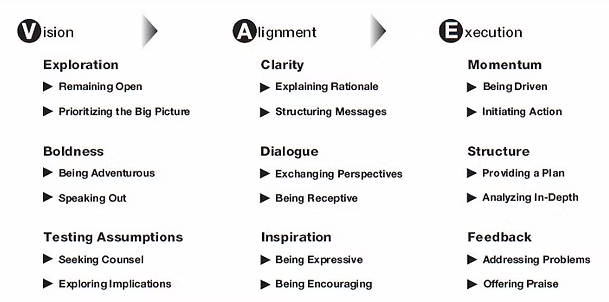Defining Leadership: What is the work of leaders in leadership? What is a good leader?
This is one of the most asked yet hardest to answer questions in business. Since the early 1900s, leadership has been extensively studied but understanding what makes a ‘good leader’ is complex and involves multiple elements. In this blog, we explore how leadership theory evolved and why we use Everything DiSC® Work of Leaders to develop emerging leaders.
Exploring Leadership Theories
In the early 1900s, leadership was something you were born with, not developed; in fact, it was called ‘Great Man Theory’. This theory focused on trait theory, identifying that certain individuals (often male, often aristocratic) had innate traits that made them natural leaders.
Theory evolved in the middle of the 20th century as researchers tried to scientifically identify what traits made leaders different from non-leaders, looking at intelligence, self-confidence, integrity, and sociability. This early research showed that while traits are a part of leadership, environment and behavior should be considered.
This led to an important shift in the 1950s away from traits-only theory to behavioral theory, looking at both who leaders are and what they do. Behavioral theory identified key behaviors – task-oriented behaviors and people-oriented behaviors – both of which could be learned. Models grew quickly from here with Fiedler’s Contingency Model and Hersey & Blanchard’s Situational Leadership theory, which spoke to the need for effective leaders to adapt their style based on their team, goals, and environments.
The next step in leadership theory was transformational leadership (leaders inspiring their teams beyond self-interest), and Servant Leadership, coined by Robert Greenleaf, focused on serving others first, their growth, and well-being. Essentially, this adds the need to have purpose and relationships play a role in leadership.
From the early 2000s to today, modern leadership models bring together traits, behaviors, and adaptability, mixed with inspiration and service.
What is the Work of Leaders Framework?
One of the frameworks that emerged from modern leadership models is the Work of leaders. Everything DiSC® Work of Leaders was developed by Wiley from the work of Straw, Scullard, Kukkonen, and Davis, who wrote “The Work of Leaders; How Vision, Alignment, And Execution Will Change The Way You Lead”. The six years of research and findings laid out in the book became foundational to Wiley’s approach, moving away from theory and offering leaders a simple structure that captures the complexity of contemporary leadership. The framework focuses on what leaders do using the VAE Model: Vision, Alignment, Execution.
Why does this framework work?
- It is simple, actionable, and scalable.
- It uses a clear structure:
- Vision: Where are we going?
- Alignment: How do we get everyone on board?
- Execution: How do we make it happen?
- It is built on real data research from over 300 leadership studies, leadership assessments, and input from real-world managers and executives.
- It is built on a range of behaviors between two opposing styles, or tendencies, which allows leaders to identify their default style and how it works, building self-awareness (key to leadership effectiveness).
Work of Leaders: Overview
Here are the three core responsibilities of Leaders:
Crafting a Vision
A good leader helps people see a future that they want to work towards, communicating a bigger purpose in ways that are motivating and understandable. Crafting a vision is imagining an improved future state that your company will make a reality through its work.
What is the impact of not having a vision?
If your team doesn’t have a vision, it can lead to a lack of direction where your team doesn’t know where they are going or why it matters… The result being that they default to busy work instead of meaningful progress. It can lead to low engagement and morale drops, as well as inconsistent decision making, leading to inconsistent priorities and wasted time. Another issue? Silos and fragmentation can take place leading to department drift, turf wars and duplicated effort.
What do the stats say about the impact of having a clear vision?
- 69% of employees say they would work harder if they felt their efforts were better recognized through clear goals and visions. (Source: Salesforce, “State of the Connected Customer”)
How do you start crafting your vision?
In Work of Leaders, the approach to crafting a vision involves leaders creating clarity about where their organization is headed. The model focuses on three areas:
- Explore Possibilities: Leaders start the process by seeking new ideas and perspectives and remain open to change.
- Be Bold: Leaders must be willing to take risks and understand that not taking risks is in itself a risk.
- Test Assumptions: Leaders should challenge the status quo, test their assumptions, and watch for blind spots.
To deepen this work, we often turn to one of our favorite authors, Patrick Lencioni, in his book “The Advantage” (2012) suggests organizations ask six critical questions about themselves that speak to prioritizing the big picture. They are:
- Why do we exist?
- How do we behave?
- What do we do?
- How will we succeed?
- What is most important, right now?
- Who must do what?
Together, these questions and the Work of Leaders behaviors provide a clear roadmap for building a compelling, grounded vision that people can believe in and act on.
Building Alignment
Good leaders listen actively, creating space for dialogue, and align teams around common goals. In its simplest terms, Building Alignment means gaining buy-in and commitment to your vision across the organization. A simple statement – a complex challenge! This means ensuring that every person understands their role in making the vision a reality. This must be done with deliberation, as leaders cannot simply expect all employees will just embrace the vision put before them.
What happens when your team doesn’t have alignment?
A lack of alignment often shows up in performance and morale issues. Without clear alignment, people get mixed messages, which can lead to teams operating on assumptions. It can lead to siloed thinking and fragmented efforts, and collaboration can break down. Other impacts? Slower execution, frustration, and lower engagement… and a strong possibility of resistance to change.
By taking the time and the energy to build alignment, leaders will conserve time and wasted energy trying to undo efforts misaligned with their vision.
What do the stats say about the impact of having strong alignment?
- Teams that report strong alignment with leadership are 53% more likely to be highly engaged. (Source: Gallup)
How do you start building alignment?
There is a delicate balance in communicating a vision, from too much information to not enough information. As the crafter of the vision, it can be easy to assume that employees already understand the intent or purpose of your vision, or over-communicate by sharing every small but irrelevant detail in communicating the vision going forward. This is more art form than science. Here are some tips to communicate your vision with clarity:
- Present your vision in a succinct, powerful, and structured message – eight words or less if possible
- Be straightforward and transparent – put yourself in the listener’s shoes
- Use visuals and metaphors if and where possible
- Explain not only the vision but the “why” of the vision
Once the vision has been communicated, the next step is dialogue amongst those who are most impacted by the vision. Dialogue is different than discussion. Dialogue is a two-way communication, not an “I talk and you listen” scenario. Exchanging perspectives with employees throughout the organization can offer great insight into how this vision may be perceived internally by employees and externally by customers and suppliers.
Think of the acronym SHU – Seen, Heard, and Understood. People simply want to have their opinions heard and respected. Most people are not naïve to believe that every opinion they share will translate to a shift in the organization’s vision, but they can at least feel that their voice was important.
Championing Execution
After crafting vision and building alignment, a good leader moves plans into action, creating structure, setting priorities and ensuring accountability. This is the hard part, as execution is often where good strategies go to die. In the Work of Leaders framework, championing execution is about creating the conditions for meaningful follow-through
What happens when your team doesn’t have a strong execution plan?
When leaders don’t champion execution, and teams don’t follow through, the impact is more costly than a flawed strategy. Plans stall and die, goals drift, and frustration builds, impacting morale. Accountability gets blurry, finger-pointing increases, and progress can slow to a crawl. Worst of all? A leader’s vision loses credibility, meaning that moving forward, big-picture talk feels empty and people disengage.
What do the stats say about the impact of execution strategy?
- 70% of strategic initiatives fail, often due to poor execution, not poor strategy. (Source: Harvard Business Review)
- Organizations with strong execution practices are 2.5 times more likely to be in the top quartile of financial performance. (Source: PwC)
How do you start building a strong execution plan?
While leaders may not necessarily be involved in the day-to-day implementation of the vision, they do own the responsibility to ensure that people have the resources they need to deliver the best results toward that vision.
In the Work of Leaders framework, building a strong execution plan means more than simply assigning tasks, it’s about leading action with intention. Great execution begins with momentum. Leaders keep energy high by creating urgency, celebrating early wins, and continually reinforcing how day-to-day work connects to the broader vision. When people see progress, they stay motivated.
Structure is the second key. Clear goals, defined roles, and supportive systems create the focus and consistency needed for teams to deliver. Without structure, even the most committed team can get lost in ambiguity. As leaders, it is not necessary to craft every detail of the plan, but to involve employees in the planning process. This translates into their support of the work they will be doing and increases the reliability of the plan itself. While the plan is iterative, it does need to stay laser-focused on the ultimate vision. Keeping abreast of how the plan is unfolding, knowing there will be hurdles and challenges, will increase the likelihood that the team will produce consistent and desired results.
Finally, strong execution requires regular, meaningful feedback. Leaders who engage in honest conversations about what’s working – and what’s not – build a culture of accountability and trust. In short, execution succeeds when leaders provide clarity, remove roadblocks, and stay actively engaged in the follow-through.
Great leadership is not about titles or authority.
As outlined in the Work of Leaders framework, being a good leader requires leaders to not only craft a compelling vision but also drive the right alignment and champion execution. When leaders excel at vision, alignment, and execution, they create a culture of engagement, accountability, and momentum. As you reflect on your own leadership journey, ask yourself:
- Have you crafted a vision for your organization, and can you succinctly and powerfully articulate that vision in eight words or fewer?
- Do your team members know what your vision is? Could they paraphrase the vision back in a way that demonstrates their understanding of the vision?
- Do you have an open dialogue with your teams where perspectives can be shared and exchanged?
- Are you the cheerleader of your vision, and do you demonstrate that to your teams through your actions?
- Do you have a well-thought-out plan with built-in checkpoints for feedback and analysis?
- Do your employees know they are appreciated and valued?
Want to bring the Work of Leaders framework to life in your organization? Let’s talk about how coaching or team training can turn vision into real results.
About the Author: Mike Mack, President
Mike Mack is a trusted Executive Coach, Consultant, and Facilitator who has been helping business teams maximize their potential since  2006 through tailored consulting, training, and coaching. Passionate about leadership, team development, and succession planning, he strives to make a positive impact in every engagement. A four-time Amazon best-selling author, Mike’s books include Remarkable Service, Relationships for Keeps, Lunch with Leaders, and Weekend Wisdom. Mike holds an MBA from Athabasca University and has completed governance training at the University of Alberta. He is an active member of several professional organizations, including the International Coaching Federation, the Institute of Corporate Directors, and the Canadian Association of Professional Speakers.
2006 through tailored consulting, training, and coaching. Passionate about leadership, team development, and succession planning, he strives to make a positive impact in every engagement. A four-time Amazon best-selling author, Mike’s books include Remarkable Service, Relationships for Keeps, Lunch with Leaders, and Weekend Wisdom. Mike holds an MBA from Athabasca University and has completed governance training at the University of Alberta. He is an active member of several professional organizations, including the International Coaching Federation, the Institute of Corporate Directors, and the Canadian Association of Professional Speakers.
Exclusive Insights for Growth—Join Our Newsletter!





